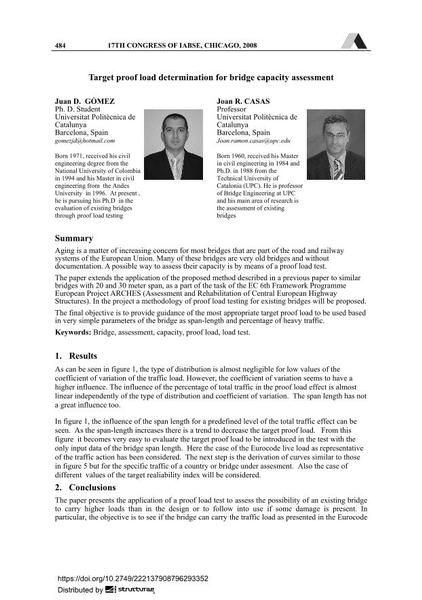Target proof load determination for bridge capacity assessment

|
|
|||||||||||
Détails bibliographiques
| Auteur(s): |
Juan David Gómez
Joan Ramon Casas |
||||
|---|---|---|---|---|---|
| Médium: | papier de conférence | ||||
| Langue(s): | anglais | ||||
| Conférence: | 17th IABSE Congress: Creating and Renewing Urban Structures – Tall Buildings, Bridges and Infrastructure, Chicago, USA, 17-19 September 2008 | ||||
| Publié dans: | IABSE Congress Chicago 2008 | ||||
|
|||||
| Page(s): | 484-485 | ||||
| Nombre total de pages (du PDF): | 8 | ||||
| Année: | 2008 | ||||
| DOI: | 10.2749/222137908796293352 | ||||
| Abstrait: |
Aging is a matter of increasing concern for most bridges that are part of the road and railway systems of the European Union. Many of these bridges are very old bridges and without documentation. A possible way to assess their capacity is by means of a proof load test. Two main questions should be solved when facing the execution of such a test: a) Which is the target load level that the bridge should resist during the proof test to guarantee a predetermined service load with a required and appropriate safety level?, and b) When the increase of loading should stop in order to not damage the structure? The answer to these questions is part of the task of the EC 6th Framework Programme European Project ARCHES (Assessment and Rehabilitation of Central European Highway Structures). In the project a methodology of proof load testing for existing bridges will be proposed. The paper extends the application of the proposed method described in a previous paper [1] to similar bridges with 20 and 30 meter span. The final objective is to provide guidance of the most appropriate target proof load to be used based in very simple parameters of the bridge as span-length and percentage of heavy traffic. |
||||
| Mots-clé: |
pont
|
||||
